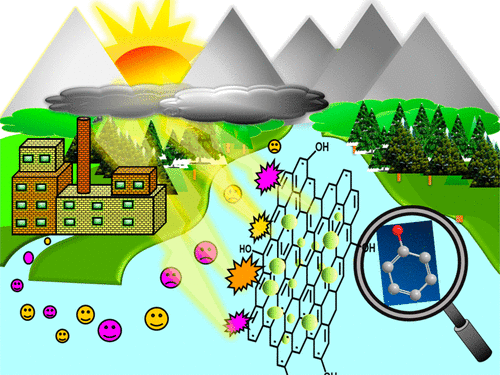当前位置:
X-MOL 学术
›
ACS Sustain. Chem. Eng.
›
论文详情
Our official English website, www.x-mol.net, welcomes your feedback! (Note: you will need to create a separate account there.)
Environmentally Sustainable Fabrication of Cu1.94S-rGO Composite for Dual Environmental Application: Visible-Light-Active Photocatalyst and Room-Temperature Phenol Sensor
ACS Sustainable Chemistry & Engineering ( IF 8.4 ) Pub Date : 2017-11-17 00:00:00 , DOI: 10.1021/acssuschemeng.7b03186 Suvanka Dutta 1 , Sourav Biswas 1 , Ram Chandra Maji 1 , Rajnarayan Saha 1
ACS Sustainable Chemistry & Engineering ( IF 8.4 ) Pub Date : 2017-11-17 00:00:00 , DOI: 10.1021/acssuschemeng.7b03186 Suvanka Dutta 1 , Sourav Biswas 1 , Ram Chandra Maji 1 , Rajnarayan Saha 1
Affiliation

|
In the present study a novel Cu1.94S-rGO (rGO = reduced graphene oxide) composite is synthesized in an ecofriendly way and its application as photocatalyst and phenol sensor is explored. The extensive microscopic and spectroscopic characterization tools were used to confirm the structures and chemical vicinity of synthesized djurleite nanocomposite. This highly permeable mesoporous composite shows a direct band gap of 2.17 eV, which confers its semiconducting properties. Wet hydrogen peroxide catalytic oxidation method of photocatalysis was adopted here for the photodegradation of model cationic and anionic dyes, which result in 90.76% and 79.44% removal efficiencies, respectively, with the fixed catalyst dose and minimum additive of 0.55 mM hydrogen peroxide dose. The removal efficiency was improved significantly by the addition of a higher amount of hydrogen peroxide. Significant reusability is also observed here in both kinds of dye molecules and is contingent on its potential applicability. It also exhibits a good response toward phenol in the range of 0.2–1.4 μM concentration by modified Cu1.94S-rGO/GCE (GCE = glassy carbon electrode). The sensing ability of such composites at a different scan rate, different pH, and with different types of molecules is also studied. The spiking recovery process inferred that a modified electrode can be a really useful device for detection and quantification of phenol in a real sample also. Surely this study opens up new possibilities for the application of inorganic semiconductor materials in the near future.
中文翻译:

双环境应用的Cu 1.94 S-rGO复合材料的环境可持续制造:可见光活性光催化剂和室温酚传感器
在本研究中,新型Cu 1.94以一种生态友好的方式合成了S-rGO(rGO =还原氧化石墨烯)复合材料,并探索了其在光催化剂和苯酚传感器中的应用。广泛的显微和光谱表征工具被用于确认合成的钙绿榴石纳米复合材料的结构和化学附近。这种高渗透性的中孔复合材料显示出2.17 eV的直接带隙,这赋予了其半导体性能。此处采用光催化的湿式过氧化氢催化氧化方法对模型阳离子和阴离子染料进行光降解,在固定的催化剂剂量和最小的添加剂为0.55 mM的过氧化氢剂量下,去除效率分别为90.76%和79.44%。通过添加更高量的过氧化氢,去除效率得到了显着提高。在这两种染料分子中也观察到了显着的可重用性,这取决于其潜在的适用性。改性的铜在0.2-1.4μM的浓度范围内也表现出对苯酚的良好响应1.94 S-rGO / GCE(GCE =玻碳电极)。还研究了这种复合材料在不同扫描速率,不同pH和不同分子类型下的传感能力。峰值恢复过程表明,修饰的电极对于检测和定量真实样品中的苯酚也可能是非常有用的设备。当然,这项研究在不久的将来为无机半导体材料的应用开辟了新的可能性。
更新日期:2017-11-19
中文翻译:

双环境应用的Cu 1.94 S-rGO复合材料的环境可持续制造:可见光活性光催化剂和室温酚传感器
在本研究中,新型Cu 1.94以一种生态友好的方式合成了S-rGO(rGO =还原氧化石墨烯)复合材料,并探索了其在光催化剂和苯酚传感器中的应用。广泛的显微和光谱表征工具被用于确认合成的钙绿榴石纳米复合材料的结构和化学附近。这种高渗透性的中孔复合材料显示出2.17 eV的直接带隙,这赋予了其半导体性能。此处采用光催化的湿式过氧化氢催化氧化方法对模型阳离子和阴离子染料进行光降解,在固定的催化剂剂量和最小的添加剂为0.55 mM的过氧化氢剂量下,去除效率分别为90.76%和79.44%。通过添加更高量的过氧化氢,去除效率得到了显着提高。在这两种染料分子中也观察到了显着的可重用性,这取决于其潜在的适用性。改性的铜在0.2-1.4μM的浓度范围内也表现出对苯酚的良好响应1.94 S-rGO / GCE(GCE =玻碳电极)。还研究了这种复合材料在不同扫描速率,不同pH和不同分子类型下的传感能力。峰值恢复过程表明,修饰的电极对于检测和定量真实样品中的苯酚也可能是非常有用的设备。当然,这项研究在不久的将来为无机半导体材料的应用开辟了新的可能性。


























 京公网安备 11010802027423号
京公网安备 11010802027423号